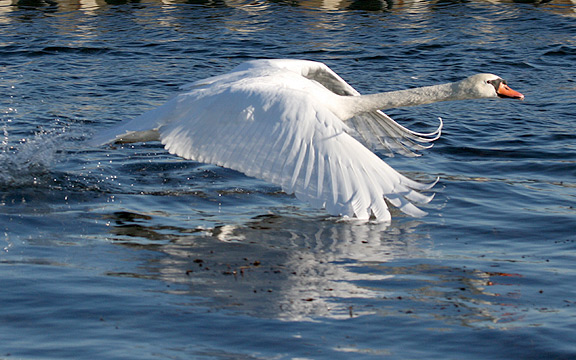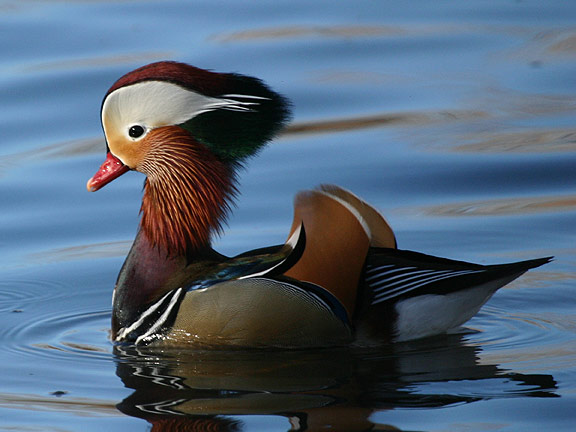Click here to read Fuzzy Math
So as you now know (if you did your homework) Ted took an interesting view of the birds observed at the park. Following the whole thing up making the statement that he recently added Indian Peafowl to his Boulder county life list. His reasoning:
The birds are here. They’re meaningfully present in the county. They’re part of the biological and cultural landscape of Boulder County. As far as I'm concerned, they count.Ah Ted, I could not agree with you more!!! Let’s bring Utah birding into the picture, with several examples that in my opinion make the case for being countable Utah birds.
California Condor
 It has now been almost 10 years since the first condors were reported from the Kolob region of Zion National Park in southwestern Utah. This may be one of the hardest to make the case for, being that these birds still rely readily on human handouts to survive. This relic of the Pleistocene simply could not survive in modern times without the help of humans. We were responsible for the demise and now are responsible for the survival—and there is no end in sight for this. I don’t think many birders can imagine a summer trip to the Kolob region with seeing a Condor soar along the cliff tops. These birds are free flying, covering wide expanses in search of food for survival. It just so happens that most of the food they end up eating is being provided by us. Unless the government has a change of plans this project is long term and these birds will continue to be seen soaring “free as a bird”.
It has now been almost 10 years since the first condors were reported from the Kolob region of Zion National Park in southwestern Utah. This may be one of the hardest to make the case for, being that these birds still rely readily on human handouts to survive. This relic of the Pleistocene simply could not survive in modern times without the help of humans. We were responsible for the demise and now are responsible for the survival—and there is no end in sight for this. I don’t think many birders can imagine a summer trip to the Kolob region with seeing a Condor soar along the cliff tops. These birds are free flying, covering wide expanses in search of food for survival. It just so happens that most of the food they end up eating is being provided by us. Unless the government has a change of plans this project is long term and these birds will continue to be seen soaring “free as a bird”.
Mute Swan
 If you have been to Washington County in the past 5 years and visited any number of local ponds or gold courses, you have likely seen the giant Mute Swans that can be found all over the county. It is no secret that these birds were all implants to add a touch of elegance to a pond here and there. But, when a pair of Mute Swan came gliding past me at Southgate Golf course one winter morning, I had to scratch my head and wonder, “how domestic are these beasts?” Any bird that is free flying and surviving without the help of humans would seem to be a countable bird in my book.
If you have been to Washington County in the past 5 years and visited any number of local ponds or gold courses, you have likely seen the giant Mute Swans that can be found all over the county. It is no secret that these birds were all implants to add a touch of elegance to a pond here and there. But, when a pair of Mute Swan came gliding past me at Southgate Golf course one winter morning, I had to scratch my head and wonder, “how domestic are these beasts?” Any bird that is free flying and surviving without the help of humans would seem to be a countable bird in my book.
Mandarin Duck
 This might perhaps be the strangest on my list, and by far the quintessential example of the “Should or shouldn’t it count game”. Mandarin Ducks have been free flying and breeding (limited) along the Wasatch front in northern Utah for countless years. What started out as bird in private collections grew into a small and local population found on random ponds, streams, and canals from Salt Lake to Ogden. Perhaps the most vivid and memorable of the three examples, when you see a Mandarin Duck you don’t forget the sighting. Now the birds obviously aren’t thriving, as we don’t see them at every park, and every pond, but every year several reports surface—letting us know they are still around.
This might perhaps be the strangest on my list, and by far the quintessential example of the “Should or shouldn’t it count game”. Mandarin Ducks have been free flying and breeding (limited) along the Wasatch front in northern Utah for countless years. What started out as bird in private collections grew into a small and local population found on random ponds, streams, and canals from Salt Lake to Ogden. Perhaps the most vivid and memorable of the three examples, when you see a Mandarin Duck you don’t forget the sighting. Now the birds obviously aren’t thriving, as we don’t see them at every park, and every pond, but every year several reports surface—letting us know they are still around.
A couple years ago I would have sang a very different story from what I am saying right now. I used to be a staunch supporter of ABA listing guidelines, and what was and wasn’t countable. Since my big year I have taken a huge step back from serious listing, and although I do keep lists, and rather thoroughly with eBird, I have included my sightings of Mute Swan and California Condor on my checklists. These birds do represent an important part of the natural system, despite how they got there or what is keeping them alive. They are there, they are meangingful, and they should count! Of course, I have always been a true believer in what is on your list is your choice—unless it comes to competitive listing. Looking at my big year list, neither Condor nor Mute Swan appears, although I saw both species numerous times.
I guess it really is situational—in that case maybe I need to add black Swan, Swan Goose, Ruddy Shelduck, Muscovy, and a handful of others to the ol’ list :)
Damn birds are great—thanks Ted for bringing this to my attention!
All Photos in this post are copyright Tim Avery.
Labels: eBird, exotics, listing, raptors, rare birds, washington county, waterfowl

11 Comments:
Interesting discussion. I'm glad eBird allows us to count species like those you mentioned. No matter their provenance, if they are living wild, especially those that are breeding and self-sustaining in the wild, they count in my book. Tracking their movements and populations is critical and interesting, so I say, Good for eBird!
Counting, it turns out, is a very subjective and personal issue. If you want to play by the ABA's or some other person's rules, more power to you, enjoy it! Birders should not judge other birders on what they count, unless they have agreed to a fun competition within a certain set of guidelines.
It is very subjective! I still don't include those Muscovy and Greylegs in eBird, but I do include the birds that are relevant to me. And that is how it should be for everyone. Count what matters to you, and keep the list that means something to you.
It is after all just birding!
Great insight. Glad to see this blog get started. Keep the posts coming.
Thanks Oliver! Hopefully this ends up being a helpful, meaningful, and useful resource for birding in Utah!
I always report every wild bird I see to eBird, including Greylags, Swan Geese, Mute Swans, and Mandarins. I encourage others to do the same because I think the data will be important for learning about how and when feral species become established. But if you ask me about my county or state list, I won't include these in the sum, because I follow ABA rules for listing. EBird is currently working on a function where you can exclude certain species from your list outputs by marking them as "not countable". But until then, I subtract them manually.
Ryan,I have to admit, your eBird checklists might be the most thorough I have ever seen! And for good reason as you point out.
Now that you mention it, I'd like to see something like Greylag Goose (domestic) or Muscovy (domestic) as eBird reporting categories. Something to bring up with my buddies at eBird...
Rob, both of those species are already available as "domestics" in eBird. If your regional reviewer hasn't enabled them in the checklists for your area, you have two options. You can either email your regional reviewer and ask them to be added to the default checklist for your area, or you can add them to your reports manually. To add them manually, click Show: Rare Species at the top of the checklist. Then type in a few letters in the "Add Species" box: "Musco. . . ." You can then click on and add "Muscovy Duck (Domestic type)". (Likewise for Graylag.) So far the only "domestic" options are for Mallard, Muscovy, and Graylag, but I think the check-box system they've talked about adding is necessary because just about anything could be "domestic." In Cache County alone, I've seen uncountable African Collared-Doves, Gambel's Quail, Mandarin Ducks, Red-crested Pochards, and Swan Geese, for example.
Utah Birders >>>>> Download Now
>>>>> Download Full
Utah Birders >>>>> Download LINK
>>>>> Download Now
Utah Birders >>>>> Download Full
>>>>> Download LINK 07
Recording success in Cryptocurrency, Bitcoin is not just buying and holding till when bitcoin sky-rocks, this has been longed abolished by intelligent traders ,mostly now that bitcoin bull is still controlling the market after successfully defended the $60,000 support level once again and this is likely to trigger a possible move towards $100,000 resistance area However , it's is best advice you find a working strategy by hub/daily signals that works well in other to accumulate and grow a very strong portfolio ahead. I have been trading with Mr Bernie doran daily signals and strategy, on his platform, and his guidance makes trading less stressful and more profit despite the recent fluctuations. I was able to easily increase my portfolio in just 1week of trading with his daily signals, growing my $3000 to $25,000 Mr Bernie’s daily signals are very accurate and yields a great positive return on investment. I really enjoy trading with him and I'm still trading with him, He is available to give assistance to anyone who love crypto trading and beginners in bitcoin investment ,he can also help you recover your lost funds I would suggest you contact him on WhatsApp : + 1424(285)-0682 , Gmail : (BERNIEDORANSIGNALS@GMAIL.COM) or Telegram : @IEBINARYFX for inquiries
Çok beğendim, paylaştığınız için teşekkürler.
Post a Comment
Subscribe to Post Comments [Atom]
<< Back to Previous